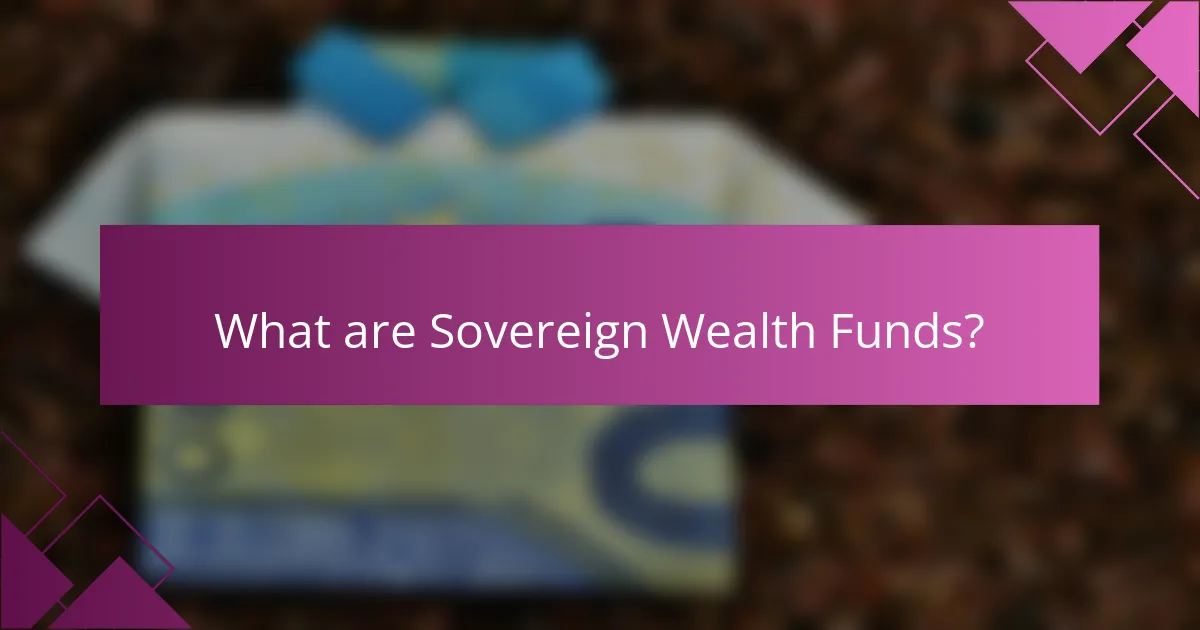
What are Sovereign Wealth Funds?
Sovereign Wealth Funds (SWFs) are state-owned investment funds or entities. They invest in various assets to achieve financial returns for their countries. SWFs typically manage surplus revenues, often derived from commodities like oil and gas. For example, Norway’s Government Pension Fund Global is one of the largest SWFs, managing over $1 trillion in assets. These funds aim to stabilize the economy, save for future generations, or fund social programs. SWFs invest in stocks, bonds, real estate, and other financial instruments. Their strategic asset allocation can vary based on national priorities and economic conditions.
How do Sovereign Wealth Funds operate?
Sovereign Wealth Funds (SWFs) operate by managing national savings for investment purposes. They invest in various asset classes, including stocks, bonds, real estate, and commodities. SWFs are typically funded by government revenues, such as surplus oil revenues or foreign exchange reserves. The objective is to generate returns that can support the country’s economy and future generations.
Investment strategies vary among SWFs, with some focusing on long-term growth while others may seek short-term returns. Governance structures differ, with some funds operating under strict regulations and others enjoying more autonomy. Transparency and accountability are critical for maintaining public trust in SWFs. According to the Sovereign Wealth Fund Institute, there are over 90 SWFs globally, managing assets exceeding $10 trillion.
What are the key components of Sovereign Wealth Funds?
Sovereign Wealth Funds (SWFs) are state-owned investment funds. They primarily invest in various asset classes to achieve long-term financial goals. Key components include funding sources, investment strategies, governance structures, and asset allocation. Funding sources typically come from national revenues, such as oil exports or foreign reserves. Investment strategies may vary, including equity, fixed income, real estate, and alternative investments. Governance structures define the management and oversight of the funds, often involving government agencies or independent boards. Asset allocation determines how investments are distributed across different asset classes to balance risk and return. These components work together to ensure the SWF meets its objectives while managing risks effectively.
How do these components influence the performance of Sovereign Wealth Funds?
Components such as asset allocation, risk management, and governance significantly influence the performance of Sovereign Wealth Funds. Asset allocation determines the mix of investments, impacting returns and volatility. For instance, a diversified portfolio can reduce risk while enhancing potential returns. Risk management practices help in identifying, assessing, and mitigating financial risks, which is crucial for maintaining fund stability. Effective governance structures ensure transparency and accountability, leading to better decision-making and trust among stakeholders. According to the International Monetary Fund, well-governed funds outperform poorly governed ones by a notable margin, highlighting the importance of these components in achieving superior performance.
What is the historical performance of Sovereign Wealth Funds?
Sovereign Wealth Funds (SWFs) have historically demonstrated strong performance, often outperforming traditional investment benchmarks. According to the Sovereign Wealth Fund Institute, the average annual return for SWFs has ranged from 5% to 8% over the past two decades. This performance is attributed to their long-term investment strategies and diversified asset allocations. Notably, the Government Pension Fund of Norway, one of the largest SWFs, reported a 9.4% return in 2020. Additionally, research by the International Monetary Fund indicates that SWFs have effectively weathered economic downturns, showcasing resilience during financial crises. Their strategic focus on alternative investments has also contributed to superior returns compared to conventional asset classes.
What metrics are used to evaluate the performance of Sovereign Wealth Funds?
Sovereign Wealth Funds are evaluated using several key metrics. Common metrics include return on investment (ROI), which measures the fund’s profitability. Another important metric is the Sharpe ratio, indicating risk-adjusted returns. The information ratio assesses the fund’s excess return relative to its benchmark. Tracking error measures the deviation of the fund’s returns from its benchmark. Additionally, the total assets under management (AUM) reflects the fund’s scale and growth. These metrics provide insights into performance, risk management, and investment effectiveness.
How have historical trends impacted current Sovereign Wealth Funds?
Historical trends have significantly shaped the structure and strategies of current Sovereign Wealth Funds (SWFs). The rise of SWFs began in the 1950s, primarily driven by oil-exporting countries accumulating surplus revenues. This led to the establishment of funds like the Kuwait Investment Authority in 1953.
Subsequent economic events, such as the 2008 financial crisis, prompted SWFs to diversify their portfolios. Many funds began investing in a broader range of assets, including equities and real estate, to mitigate risks.
Additionally, the increasing globalization of markets has influenced SWFs to adopt more sophisticated investment strategies. This includes a focus on sustainable and responsible investing, reflecting a shift in societal values and expectations.
Data shows that as of 2021, over 80% of SWFs have incorporated environmental, social, and governance (ESG) criteria into their investment processes. Historical trends in global economic shifts and asset performance continue to inform the strategic decisions of these funds today.
What factors contribute to the risk profiles of Sovereign Wealth Funds?
Sovereign Wealth Funds (SWFs) face risk profiles influenced by several factors. These factors include market volatility, geopolitical risks, and asset allocation strategies. Market volatility can affect the value of investments held by SWFs. Geopolitical risks arise from political instability in the countries where investments are made. Asset allocation strategies determine the diversification of investments and their exposure to various market conditions. Additionally, currency fluctuations can impact the returns on foreign investments. Regulatory changes in both home and host countries can also alter risk profiles significantly. These elements collectively shape the financial outcomes and risk exposure of Sovereign Wealth Funds.
What are the different types of risks associated with Sovereign Wealth Funds?
Sovereign Wealth Funds face several types of risks. These include market risk, which arises from fluctuations in asset prices. Liquidity risk can occur when funds cannot be quickly converted to cash without a loss in value. Credit risk involves the possibility of default by bond issuers or counterparties. Operational risk includes failures in internal processes or systems. Political risk affects investments due to changes in government policies or instability. Currency risk arises from fluctuations in exchange rates. Each of these risks can impact the overall performance and stability of Sovereign Wealth Funds.
How do geopolitical factors influence the risk profiles of Sovereign Wealth Funds?
Geopolitical factors significantly influence the risk profiles of Sovereign Wealth Funds (SWFs). These funds are affected by political stability, international relations, and economic policies. For instance, instability in a region can lead to increased risk for investments held by SWFs. Historical examples include the impact of the Arab Spring on Middle Eastern SWFs, which faced heightened risk due to political upheaval. Additionally, trade tensions between countries can alter the investment landscape for SWFs. Changes in tariffs or sanctions can directly affect asset valuations. Furthermore, geopolitical conflicts can lead to market volatility, increasing the risk associated with SWF portfolios. Overall, the interplay between geopolitical dynamics and investment strategies shapes the risk profiles of these funds.

What are the asset allocation strategies of Sovereign Wealth Funds?
Sovereign Wealth Funds (SWFs) employ various asset allocation strategies to optimize returns and manage risk. These strategies often include diversification across asset classes such as equities, fixed income, real estate, and alternative investments. SWFs typically allocate a significant portion of their portfolios to equities for long-term growth potential. They also invest in fixed income securities to provide stability and income. Real estate investments are used for inflation hedging and income generation. Alternative investments, including private equity and hedge funds, are included for higher returns and diversification.
According to the International Monetary Fund, the average allocation of SWFs is approximately 40% in equities, 30% in fixed income, and 30% in alternatives and real estate. This allocation varies based on the fund’s objectives, risk tolerance, and market conditions. For instance, the Norway Government Pension Fund Global primarily focuses on equities and fixed income, while the Abu Dhabi Investment Authority has a more significant allocation to alternatives. These strategies reflect the funds’ goals of long-term capital growth and risk management.
How do Sovereign Wealth Funds determine their asset allocation?
Sovereign Wealth Funds determine their asset allocation based on their investment objectives, risk tolerance, and market conditions. They typically follow a strategic asset allocation framework. This framework includes a long-term investment strategy that aligns with their financial goals.
Funds evaluate various asset classes such as equities, fixed income, real estate, and alternative investments. They assess historical performance and volatility of these asset classes. Risk management is a crucial factor in their decision-making process.
Sovereign Wealth Funds often utilize modern portfolio theory to diversify their investments. This theory emphasizes the importance of asset correlation in minimizing risk. Additionally, they may adjust allocations based on macroeconomic indicators and geopolitical factors.
Research shows that successful asset allocation can enhance returns while managing risks effectively. A study by the International Monetary Fund found that diversified portfolios generally outperform concentrated ones over time.
What factors influence asset allocation decisions in Sovereign Wealth Funds?
Asset allocation decisions in Sovereign Wealth Funds (SWFs) are influenced by several key factors. These factors include the fund’s investment objectives, risk tolerance, and the economic environment. The investment objectives define the desired outcomes, such as capital preservation or growth. Risk tolerance determines how much volatility the fund can withstand. Economic conditions, including interest rates and market trends, impact investment choices. Additionally, regulatory frameworks and geopolitical considerations also play significant roles. Historical performance data informs future allocation strategies. Research shows that SWFs often adjust their portfolios in response to changing market dynamics.
How does diversification play a role in asset allocation strategies?
Diversification is crucial in asset allocation strategies as it reduces risk and enhances returns. By spreading investments across various asset classes, such as stocks, bonds, and real estate, investors mitigate the impact of poor performance in any single investment. Studies show that diversified portfolios tend to exhibit lower volatility compared to concentrated ones. For example, the 2008 financial crisis highlighted how diversified portfolios performed better than those heavily invested in equities. This strategy allows investors to capture gains from different sectors while minimizing losses during downturns. Thus, effective diversification is a fundamental principle in asset allocation that supports long-term financial stability.
What are the common asset classes in Sovereign Wealth Funds?
Common asset classes in Sovereign Wealth Funds include equities, fixed income, real estate, and alternative investments. Equities represent ownership in companies and can provide growth potential. Fixed income investments, such as bonds, offer steady income and lower risk. Real estate investments provide diversification and potential appreciation. Alternative investments include hedge funds, private equity, and commodities, which can enhance returns and reduce volatility. According to the Sovereign Wealth Fund Institute, over 40% of assets are typically allocated to equities, while fixed income usually comprises around 25%.
What role do equities play in Sovereign Wealth Funds?
Equities are a significant component of Sovereign Wealth Funds (SWFs). They provide potential for high returns over the long term. SWFs invest in equities to diversify their portfolios. This diversification helps to mitigate risk associated with other asset classes. Historical data shows that equities have outperformed many other investments over extended periods. For instance, the annualized return of global equities has averaged around 7% to 10% over the last several decades. By holding equities, SWFs can capitalize on economic growth and market trends. This strategy aligns with their long-term investment objectives. Thus, equities play a crucial role in enhancing the overall performance of Sovereign Wealth Funds.
How do fixed income investments fit into the asset allocation of Sovereign Wealth Funds?
Fixed income investments are a critical component of the asset allocation strategy for Sovereign Wealth Funds (SWFs). They provide stability and predictable returns, which balance the higher volatility associated with equities. SWFs typically allocate a significant portion, often ranging from 20% to 60%, of their portfolios to fixed income assets. This allocation helps to mitigate risks and ensure liquidity.
Furthermore, fixed income investments are essential for preserving capital and generating income. They allow SWFs to meet future liabilities and funding requirements. According to the International Working Group of Sovereign Wealth Funds, a diversified fixed income portfolio can enhance overall portfolio performance.
In summary, fixed income investments are integral to the risk management and financial sustainability of Sovereign Wealth Funds.

What are the best practices for evaluating Sovereign Wealth Funds?
Best practices for evaluating Sovereign Wealth Funds include assessing their investment strategies and performance metrics. Evaluators should analyze historical returns to gauge effectiveness. Risk profiles should be examined to understand volatility and exposure levels. Asset allocation strategies must align with long-term goals and economic conditions. Transparency and governance structures are critical for accountability. Regular audits and compliance checks enhance trust and reliability. Benchmarking against similar funds provides context for performance evaluation. Engaging with stakeholders ensures alignment with national interests and objectives.
How can investors assess the effectiveness of Sovereign Wealth Funds?
Investors can assess the effectiveness of Sovereign Wealth Funds (SWFs) by analyzing their historical performance, risk profiles, and asset allocation strategies. Historical performance metrics include annualized returns and volatility over specific time frames. Investors should compare these metrics against relevant benchmarks, such as market indices or peer SWFs.
Risk profiles can be evaluated through measures like Sharpe ratios, which indicate risk-adjusted returns. A higher Sharpe ratio suggests better risk management. Asset allocation strategies provide insights into diversification and investment focus. Investors should assess the proportion of assets allocated to different classes, such as equities, fixed income, and alternative investments.
Additionally, transparency and governance structures of SWFs play a crucial role in effectiveness assessment. Funds that adhere to the Santiago Principles often demonstrate higher accountability and performance. Regular reporting and independent audits further enhance credibility. These factors combined offer a comprehensive view of an SWF’s effectiveness.
What tools and metrics are useful for evaluating Sovereign Wealth Funds?
Common tools and metrics for evaluating Sovereign Wealth Funds include performance benchmarks, risk-adjusted returns, and asset allocation analysis. Performance benchmarks compare fund returns against market indices or peer funds. Risk-adjusted returns, such as the Sharpe ratio, assess returns relative to the level of risk taken. Asset allocation analysis examines the distribution of investments across different asset classes. Additional metrics include liquidity ratios and tracking error, which measure how closely a fund’s performance aligns with its benchmark. These tools provide insights into fund efficiency, risk management, and overall investment strategy effectiveness.
What tips should investors consider when analyzing Sovereign Wealth Funds?
Investors should consider several key tips when analyzing Sovereign Wealth Funds. First, examine the fund’s historical performance. Historical performance provides insights into the fund’s ability to generate returns over time. Second, assess the fund’s risk profile. Understanding the risk tolerance helps in evaluating potential volatility and investment strategies. Third, review the asset allocation strategies. A diversified portfolio can mitigate risks and enhance returns. Fourth, investigate the governance structure. Strong governance ensures accountability and effective management of assets. Fifth, analyze the fund’s investment objectives. Clear objectives align with the investor’s goals and risk appetite. Lastly, consider the economic and political environment of the fund’s home country. This context can significantly impact the fund’s performance and stability.
Sovereign Wealth Funds (SWFs) are state-owned investment entities that manage national savings and invest in various asset classes to achieve financial returns and support economic stability. This article evaluates the historical performance of SWFs, highlighting their average annual returns and resilience during economic downturns. It also examines the risk profiles influenced by market volatility, geopolitical factors, and asset allocation strategies, detailing how diversification plays a crucial role in managing risk. Additionally, best practices for assessing the effectiveness of SWFs, including performance metrics and governance structures, are discussed to provide a comprehensive understanding of their investment strategies.
